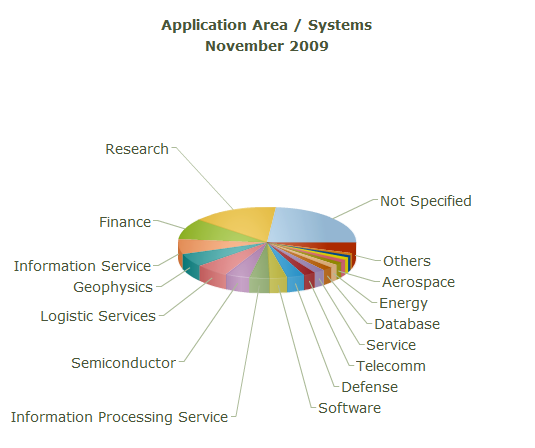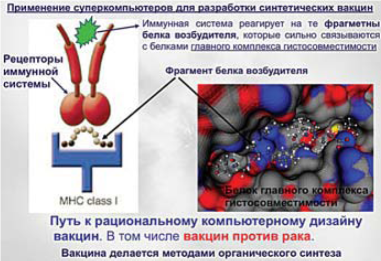Supercomputer technologies in science, education and industry

Recently, respected and worthy organizations such as Moscow State University, Russian Academy of Sciences and the Supercomputer Consortium of Russian Universities published the book Supercomputer Technologies in Science, Education and Industry. The book was edited by Academician V.A. Sadovnichiy, academician G.I. Savina, Corr. RAS Vl.V. Vojvodina, that is no less worthy sirs. The book focuses on how to use those things that are usually considered "space" in practice. However, at present, supercomputer technologies cease to be only a scientific field and begin to solve more and more practical issues related to design and production. I will give a few examples of the use of supercomputers in this book.
First, I’ll give a chart from top500.org, which shows which tasks in the world are solved with the help of super computers.

Figure 1 - Tasks solved on supercomputers
')
Well, quite a variety of tasks. And what of this list is used in Russia? Let's walk through the chapters of the book.
Supercomputer technology in medicine

Figure 2 - The use of supercomputers for the development of synthetic vaccines
The search for inhibitor molecules for target proteins constitutes the initial stage of the development of a new drug. It is possible to significantly reduce the time and money spent on the inhibitor search stage using supercomputer technologies and computer molecular modeling techniques. This makes it possible to predict new organic molecules that will most effectively and selectively bind to the active centers of the studied proteins. The joint work of the Moscow State University and the Hematological Research Center of the Russian Academy of Medical Sciences was devoted to the development of a new patent-pure synthetic thrombin inhibitor, and the approach was developed in the process of finding ways to create a number of other drugs.
The use of supercomputers in mechanical engineering
NPO Saturn OJSC is a leading engine-building company in Russia specializing in the development and production of gas turbine engines for military and civil aviation, navy vessels, power generating and gas pumping units. The company is actively using supercomputers in the design of aircraft engines.

Figure 3 - Aviation engine developed in a virtual design environment
Another interesting example is the topic "Optimization of the profile of the iron wheel." At first, the name may not seem serious, but behind it lies a serious practical meaning. The Russian Railways company owns about 20 thousand locomotives and more than 600 thousand freight and passenger cars. Reducing the wear of railway wheels and rail tracks by percentages can give a huge economic effect, and improving the stability of the car while driving will increase safety and increase the average speed. The meaning of optimization is obvious, but where does high-performance computing come from?
If we look for the optimum using the exhaustive search on the grid of the required accuracy, we get the following. Taking ten variants of the value of each of the parameters, we get 10 ^ 11 calculations, which gives about 10 ^ 12 seconds, that is, 3 years of continuous counting on a supercomputer with 10,000 processors. Thus, the complexity of the problem is such that high-performance computing is not only necessary, but must also be complemented without fail by effective numerical solution methods for obtaining a result in a foreseeable time frame.

Figure 4 - The trajectory of the wheel pair
Oil, gas and supercomputers
The efficiency of work in the oil and gas industry is directly related to the use of powerful supercomputers to solve large-scale computational problems that ensure the quality of search and exploration of oil and gas fields, increase the productivity of existing wells and reduce environmental damage during their development.

Figure 5 - Example of a field model
Other sections in the book
In addition to the above, the book discusses examples of the use of supercomputers in many other industries:
• climate, the study of the atmosphere;
• city flood protection system;
• gas detonation, pressure distribution;
• and many many others.
However, there were some high-tech applications that were “cut off from life” :). For example, in Russia they have to develop an “Angara” strategic supercomputer. It should be "better than all" other computing systems. However, while only the simulation of the Angara supercomputer is being performed on another computer. That is, made an emulator. It’s as if AvtoVAZ, instead of a new car model, developed and described an addition to Need For Speed. :)
Where to read?
The purpose of my recording was not to retell the whole book, I just want to interest people so that everyone could get to know it and learn about the various options for using supercomputers in Russia. The book is available in electronic form here !
Well, and a question for the readers - are any of you working on similar supercomputer systems?
Source: https://habr.com/ru/post/84407/
All Articles